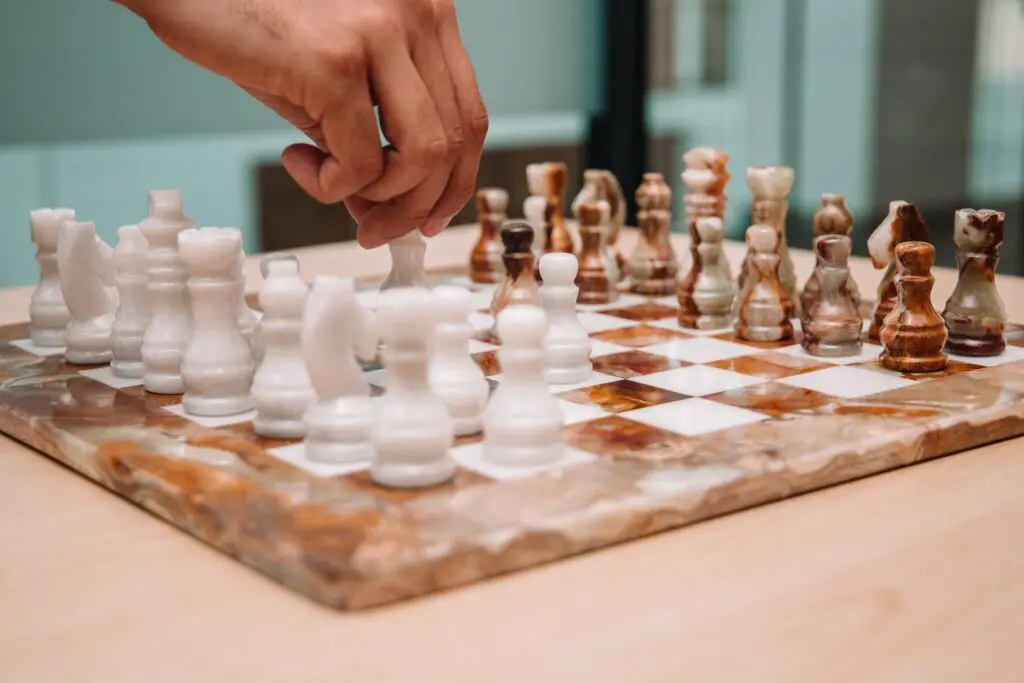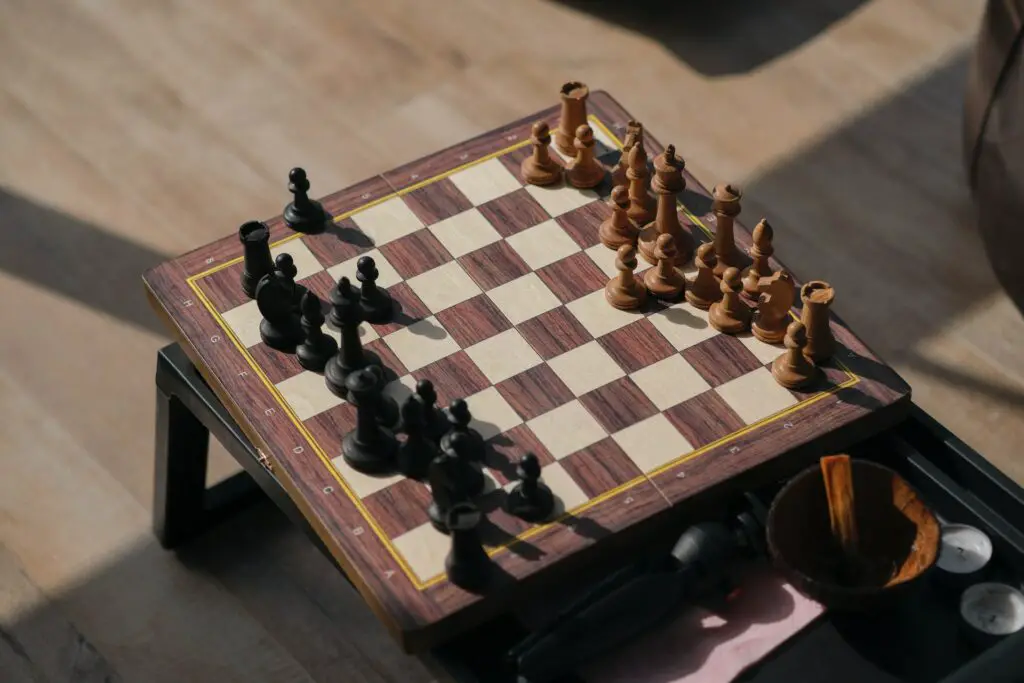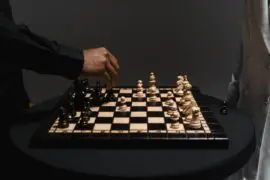In the intricate world of chess, the ultimate goal for players is to achieve checkmate with a rook and king – a move that leaves the opponent’s king with no escape, signaling the end of the game and the sweet taste of victory. Mastering checkmating scenarios with a rook and king is a pivotal aspect of a chess player’s skill set, allowing them to outwit opponents and emerge triumphant.
In this article, we will delve into the significance of checkmate in chess and explore the art of achieving this coveted checkmate with rook and king. By focusing on this particular scenario, we will unlock the strategic potential of these two pieces, enabling players to sharpen their skills and gain a competitive edge on the chessboard.
Understanding the Rook’s Power
Contents
The rook is one of the most potent and formidable chess pieces in the intricate chess game. Resembling a tower, the rook holds significant sway over the game’s outcome due to its unique movement and strategic capabilities.

The rook’s movement is defined by its ability to traverse any number of squares horizontally or vertically on the chessboard. It lacks the diagonal mobility of a bishop but compensates with its exceptional control over files (vertical columns) and ranks (horizontal rows). This means a rook can swiftly maneuver across the board, covering long distances in a single move.
Such versatile movement gives the rook an edge in securing control of crucial areas and launching attacks. It can dominate an entire rank or file, making it a key piece for creating threats and forcing the opponent’s king into confined spaces.
When it comes to checkmating strategies, the rook plays a pivotal role. Its capacity to deliver long-range attacks and control critical paths on the board sets the stage for deadly checkmate threats. Alongside the king, the rook can form lethal combinations to trap the opposing king, forcing it into a checkmate position where no escape is possible.
Mastering the art of utilizing the rook effectively in checkmating scenarios is a fundamental aspect of chess strategy. By understanding the rook’s immense power to control files and ranks, players can leverage its capabilities to orchestrate brilliant checkmate maneuvers and emerge as true chess tacticians.
The Checkmate Goal
In the enthralling realm of chess, the ultimate goal is to achieve checkmate, a decisive move that marks the end of the game and crowns the victor. The heart of this timeless game revolves around maneuvering your pieces strategically to corner the opponent’s king, leaving it in imminent peril from which there is no escape.
Checkmate is the culmination of a player’s strategic prowess, tactical finesse, and calculated moves. When a king is in check, meaning it is under direct attack and threatened with capture, the player must take immediate action to protect the king. If no legal moves can be made to safeguard the king or block the attack, the king is checkmated, and the game concludes.
As the word suggests, checkmate represents when the king is “mated” or trapped beyond salvation. The player delivering the checkmate emerges as the triumphant force on the chessboard, celebrating a hard-earned victory over their opponent.
Checkmate is the ultimate measure of skill and wit in chess. Players must continuously strategize, anticipate their adversary’s moves, and position their pieces artfully to secure a favorable outcome. With the checkmate goal at the heart of the game, chess enthusiasts engage in battles of the mind, honing their abilities and immersing themselves in the timeless pursuit of mastering this captivating game of kings.
Setting Up the Board
In mastering the checkmating scenario with a rook and king against an opposing king, a clear understanding of the starting position on the chessboard is essential. Visualizing this setup sets the stage for executing the checkmate with precision and finesse.
Explanation of the basic positions of each piece on the chessboard:
1. Rook (R): The book starts in the corner of the chessboard, occupying either square h1 (for White) or h8 (for Black). The rook can move horizontally or vertically, covering any squares in these directions.
2. King (K): The king begins next to the rook, either on square g1 (for White) or g8 (for Black). The king is crucial, and his safety is paramount during the game. It can move in any direction, but only one square at a time.
3. Opposing King: The opponent’s king is positioned diagonally across from the rook and king pair on square g8 (for White) or g1 (for Black). Like the other king, it can move in any direction, but only one square at a time.
With this clear visual representation and understanding of the pieces’ initial positions, players are primed to embark on the thrilling journey of orchestrating the checkmate using the rook and king duo, seeking to outwit their adversary and secure victory on the chessboard.
The Step-by-Step Process
Achieving checkmate with just a rook and king against an opposing lone king requires strategic precision and careful maneuvering. Let’s delve into the step-by-step guide to accomplishing this checkmating scenario:
Step 1: King and Rook Coordination
– Position your rook and king side by side, with the king leading the way.
– Ensure that the opposing king is not in a position to attack your rook or king at this stage directly.
Step 2: Closing in on the Opposing King
– Gradually move your king and rook closer to the opposing king, limiting its available moves.
– Be cautious not to place your king or rook in a position where the opposing king can capture them.
Step 3: Box the Opposing King
– Gradually box in the opposing king using your rook and king’s coordinated movements.
– Ensure the opposing king has limited squares to move and cannot escape your grasp.

Step 4: Deliver the Checkmate
– With the opposing king confined to a corner or an edge of the board, deliver the checkmate using your rook.
– Move your rook to a square where it directly attacks the opposing king without legal moves to escape.
Congratulations! You have achieved checkmate with a rook and king against the opposing king, securing a triumphant victory on the chessboard.
Following this step-by-step process and understanding the key moves and principles, you can confidently employ the rook and king combination to masterfully checkmate your opponents in thrilling chess encounters.
Common Mistakes to Avoid
When attempting to checkmate with a rook and king against an opposing king, players can fall into several common pitfalls that may hinder their success on the chessboard. Awareness of these mistakes is crucial for honing checkmating skills, avoiding missed opportunities, or ending up in a stalemate.
1. Premature Advancement:
One frequent mistake is rushing the advancement of the king and rook without proper coordination. Moving the rook too early may allow the opposing king to escape or create defensive counterplay. Premature advancement can also expose the rook to unnecessary risks, leading to its capture.
2. Inadequate King Safety:
Neglecting the safety of your king is another critical mistake. Leaving the king vulnerable to checks can result in perpetual checks or a stalemate, where the game ends in a draw. Protecting the king while executing the checkmate is essential to secure a successful outcome.
3. Neglecting Opposition:
Failing to recognize the concept of opposition during the checkmating process can lead to missed opportunities. The opposition refers to the position where both kings face each other with an odd number of squares in between. Utilizing opposition allows the checking player to gain more control over the board and secure a more efficient checkmate.
4. Overcommitting the Rook:
Overcommitting the rook to a position where it can no longer effectively control the board is a common mistake. This can allow the opposing king to escape the checkmate and prolong the game, leading to potential counterplay by the opponent.
Tips to Avoid Mistakes and Improve Checkmating Skills:
1. Patience and Coordination:
Exercise patience and ensure proper coordination between the king and rook. Move them together harmoniously, gradually closing in on the opposing king while maintaining their safety.
2. Protect the King:
Prioritize the safety of your king throughout the checkmating process. Avoid unnecessary risks and ensure it is not vulnerable to checks or potential threats.
3. Understand Opposition:
Master the concept of opposition and use it to your advantage. Utilize opposition to control the board efficiently and hasten the checkmating process.
4. Preserve Rook Mobility:
Keep the rook’s mobility intact by avoiding unnecessary moves that may restrict its reach. Preserve its ability to control files and ranks effectively.
5. Practice Regularly:
Practice checkmating with a rook and king against an opposing king regularly to improve your skills and build confidence in executing the checkmate.
By being mindful of these common mistakes and implementing the tips, players can navigate the checkmating scenario with greater proficiency, maximizing their chances of securing the coveted checkmate victory on the chessboard.
Developing Checkmating Skills
Mastering checkmating skills with rook and king combinations requires consistent practice and strategic thinking. Here are some practical tips to develop and refine your checkmating abilities on the chessboard:
1. Study Classic Checkmate Patterns:
Familiarize yourself with classic checkmate patterns involving a rook and king against a lone king. Learn patterns like the “Back Rank Mate” and the “King in the Corner” technique. Understanding these patterns will enhance your ability to recognize potential checkmating opportunities during games.
2. Practice Coordination:
Work on improving the coordination between your rook and king. Practice moving them together seamlessly to control crucial board areas and set up potential checkmate positions.
3. Create Checkmate Scenarios:
Set up checkmate scenarios against an opposing lone king on the chessboard. Practice executing the checkmate step-by-step with your rook and king while preventing the opponent’s king from escaping.
4. Utilize Opposition:
Understand the concept of opposition and use it strategically during checkmating attempts. Leveraging the opposition will help you gain a positional advantage, making it easier to achieve checkmate.
5. Analyze Grandmaster Games:
Study games played by grandmasters and observe how they execute checkmates with a rook and king. Analyzing their moves and thought processes will provide valuable insights into effective checkmating strategies.
Practice Routines:
1. Rook Endgames Practice:
Focus on rook endgames to improve your understanding of rook maneuvering and checkmating techniques. Solve puzzles and practice positions where you can achieve checkmate using a rook and king against an opposing king.
2. Checkmate Drill:
Devote time to a checkmate drill where you attempt to checkmate the opposing king with a rook and king combination as quickly and efficiently as possible. Set a timer to challenge yourself and track your progress over time.
3. Checkmate Challenges:
Engage in friendly games with fellow chess enthusiasts, focusing on checkmating opportunities. Challenge each other to achieve checkmate using a rook and king, fostering a competitive and learning-oriented environment.

4. Play Against Chess Engines:
Utilize chess engines or computer programs to practice against various levels of AI. These programs can provide various opponents, helping you refine your checkmating skills against different playing styles.
Remember, developing checkmating skills with a rook and king is a gradual process that requires dedication and consistent practice. By immersing yourself in study, exercises, and practice games, you can steadily enhance your checkmating abilities and become a more formidable chess player.
Checkmate with rook and king.
Mastering checkmating with a rook and king in chess is crucial for becoming a skilled player. Understanding the rook’s power and learning from illustrative examples are key elements of this process. Regular practice and application of strategies will boost confidence and proficiency in checkmating opponents. By embracing these principles, players can elevate their game and relish the thrill of achieving checkmate on the chessboard.
Is a chess board the same as a checkers board? Bitter Truth – 100%




